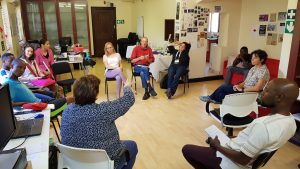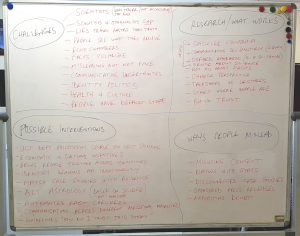December 4, 2017
Prompted by the (wilful or not) misunderstandings about science and apparent loss of faith in experts, we dedicated a session to examining the foundations of critical thinking and science communication.
We invited two external experts:
- Ms Marina Joubert from Stellenbosch University’s Centre for Research on Evaluation, Science and Technology (CREST)
- Dr Elisa Galgut from University of Cape Town’s Department of Philosophy
Marina gave an overview of tools and attitudes in science communication (5.8 MB pdf of the presentation). She related how the expectations of scientists are different in the era of social media compared to when most science communication was done by science journalists. She highlighted a number of resources for science communicators, e.g.
- The NAS Sackler colloquia on the science of science communications
- Communicating Science Effectively (free PDF download)
- Oxford Handbook on the Science of Science communication
Elisa gave an overview of her research interests, which included irrationality, philosophy of psychoanalysis and philosophy of literature. Through this lens, we discussed challenges of communication, among others that:
- facts polarize and people relate to what they already believe
- social media creates echo chambers
- communicating scientific uncertainty is challenging because experts appear “not to know” and people exploit that uncertainty
The picture of the whiteboard (below) shows the main topics of discussion, and how they grouped broadly into challenges (including how people can be misled), what strategies work in science communication, and finally, what interventions might be useful.
The following options for interventions were raised:
- A course on critical thinking specifically focussed on scientists. See the current 1st year course on Critical thinking at UCT.
- Identifying and addressing root causes of irrationality
- Communicating science by using a mixture of case studies and supporting evidence
- Alt-Astrology: A “horoscope” that used your *actual* zodiac sign (1 of 13) and related to real, transient objects in the universe/solar system in both a funny and informative way. (Leads: Catherine Cress and Adi Eyal)
- Guidelines on trusting information sources (for lay people)
January 3, 2018
This was a continuation of the previous #FullMoonMashup discussion on this hot topic. We decided to keep this one online due to the full moon happening in the middle of what is generally a holiday period in South Africa. There was a small turnout (5 people in total) but interesting conversations took place.
Summary:
Suresh and Upendra from NASO gave an overview of the challenges related to this topic in Nepal:
– There is a general lack of dedicated science journalists in Nepal so the media can often make mistakes that confuse what is science and what is psuedoscience
– NASO is often approached to verify stories and a large percentage of time can be spent on this.
– There is a lot of influence in Nepal from Indian media – which can have both pros and cons
– NASO is trying to set up Memoranda of Understanding between various social media groups to ensure that information going out is accurate.
Ram joined from IUCAA in India and related challenges in that country:
– In India there is a history of mixing science and religion e.g. there was a session on Mythological Science at the National Science Congress (it was noted that such interactions could in fact be positive because it creates dialogue between communities which may not interact otherwise)
– A challenge related to the “decolonising science” conversation is that schools are teaching students to value mythological science as well.
– There are several activist groups in India but they are small and may not have significant influence.
– A major challenge is that some practicing scientists could champion various pseudoscience agendas.
The following potential invterventions came up during the conversation:
– Hold a “build-off” to challenge pseudoscientists to “prove” the effectiveness of their beliefs e.g. in South Africa there is a belief that lightning can be created by certain people – one could have a challenge where a scientist “creates” lightning and a psuedoscientist is asked to do the same; in Nepal some groups claim to be able to build satellites (“psuedo-engineers”); etc.
– Activist groups from India could interact with groups in Nepal – they may not have as much influence in a big country like India compared to a smaller one like Nepal.
– Try to hold “controlled controversy” sessions at science meetings where pseudo-scientists are invited to debate their ideas with relevant scientists.
– A project that was also highlighted at the previous discussion: draw people into an astrological predictor/platform which gives people their “real” star signs based on the actual astronomical position of objects and publish “horoscopes” that are linked to actual astronomical events e.g. transients, gravitational wave detection, etc. Once people are drawn in then engage with them on the science or non-science of making predictions about people’s lives based on astronomical objects.
Back to Astro4Dev Full Moon Mashups


